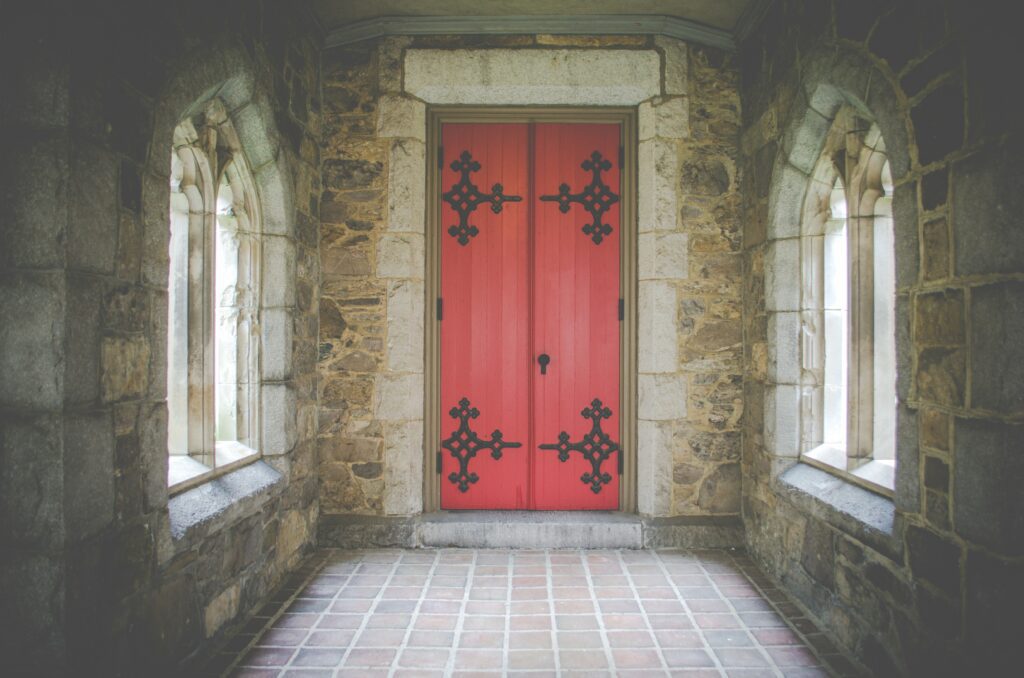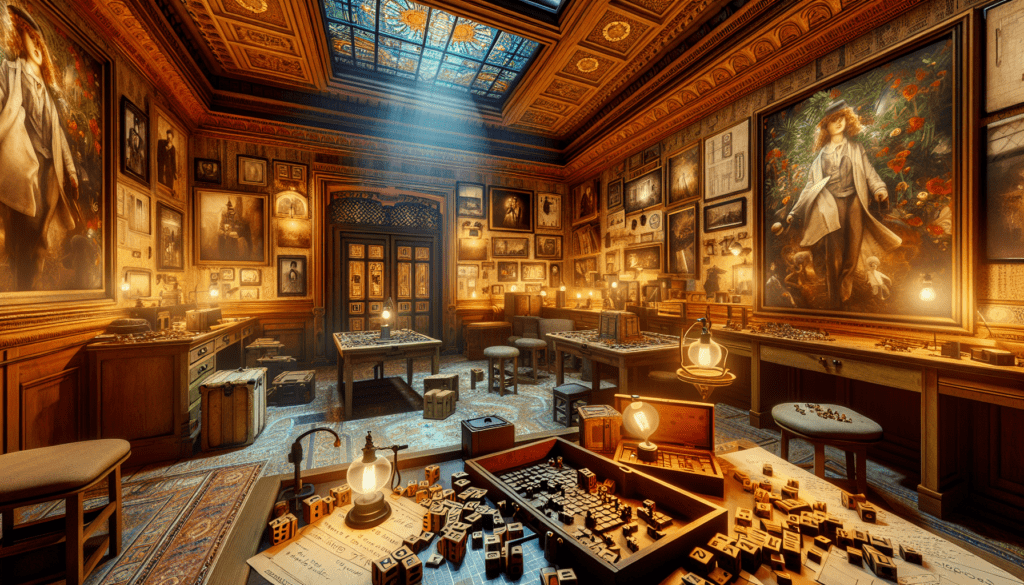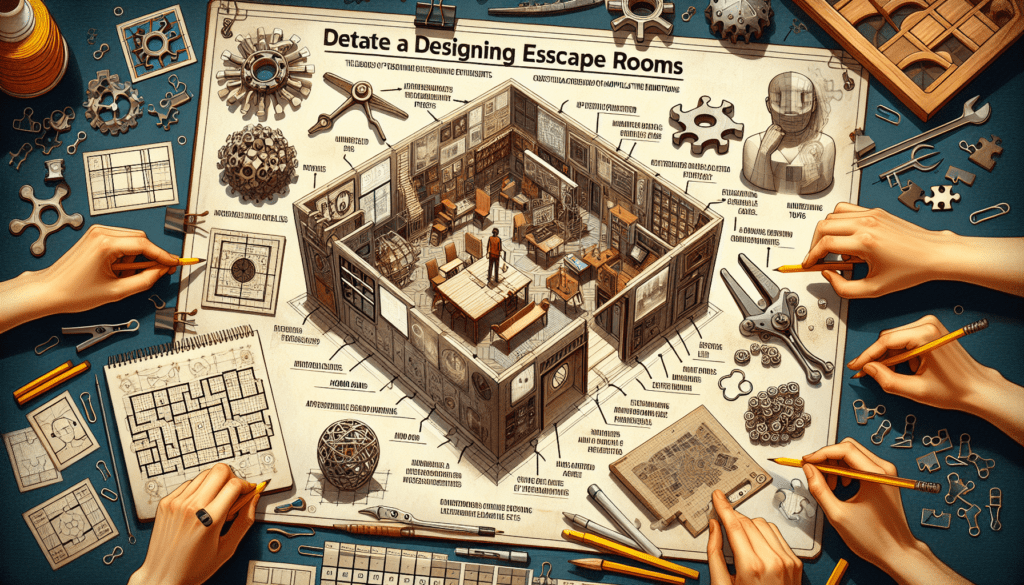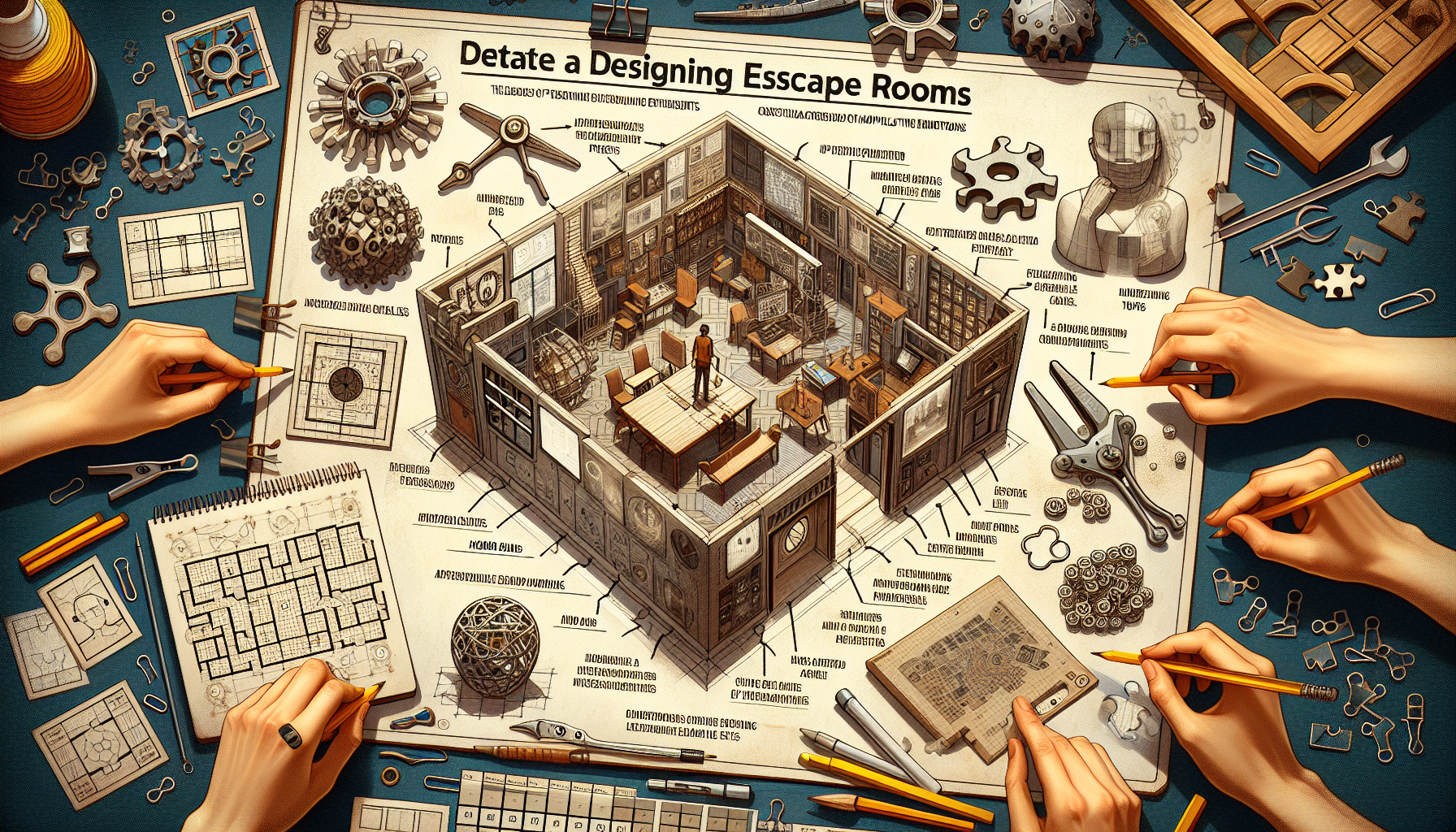Are you curious about the intricate process behind designing escape rooms? If you’ve ever wondered how these captivating and thrilling experiences are crafted, look no further. In this article, we will explore the art of designing escape rooms, uncovering the secrets, challenges, and creative techniques that go into creating an unforgettable escape adventure. Get ready to embark on a behind-the-scenes journey that will unveil the magic behind these immersive and mind-bending puzzles.

Creating a Concept
Designing a captivating escape room starts with creating a strong concept that will engage and intrigue your players. This concept serves as the foundation for all the puzzle design, room layout, and overall experience you will create.
Choosing a Theme
The theme of your escape room is what sets the stage for the entire experience. It’s important to choose a theme that resonates with your target audience and sparks their imagination. Whether it’s a mystery, adventure, fantasy, or horror theme, make sure it aligns with the interests and preferences of your players. Remember, the theme should be reflected in every aspect of the room, from the puzzles to the props, to truly immerse participants in the story.
Developing a Storyline
Once you have chosen a theme, it’s time to develop a compelling storyline that will captivate your players from the moment they enter the room. The storyline serves as the backbone of the game and ties all the elements together. Create a narrative that builds suspense, curiosity, and a sense of urgency. Make the players feel like the protagonists in their own thrilling adventure, solving puzzles to unravel the mystery or achieve a goal. The storyline should be well thought out and provide a clear objective for the players to work towards.
Determining the Difficulty Level
Finding the right balance of difficulty is crucial to ensure that your escape room appeals to a wide range of players. Consider the experience and skills of your target audience when determining the difficulty level. Ensure that the puzzles provide a challenge but are not overly frustrating. Incorporate a mix of different types of puzzles, such as logical, mathematical, observational, or physical, to cater to different players’ strengths and keep the game engaging. Remember to offer different difficulty options, so players of all skill levels can enjoy the experience.
Designing the Puzzles
Puzzles are the heart and soul of any escape room. They are what keep players engaged, thinking critically, and working together to solve the mystery. Designing an array of well-crafted puzzles is essential to create an immersive experience that challenges and delights your players.
Brainstorming Puzzle Ideas
Let your creativity flow and brainstorm a variety of puzzle ideas that align with your chosen theme and storyline. Think outside the box and consider puzzles that require players to use their problem-solving skills, think laterally, and work collaboratively. Brainstorming sessions with a team or seeking inspiration from other escape rooms can help generate fresh and innovative puzzle concepts.
Mapping out Puzzle Flow
Once you have a collection of puzzle ideas, it’s important to map out the flow of the puzzles within the room. Consider how the puzzles will connect to each other and how they will contribute to the overall storyline. Ensure that the progression is logical and cohesive, with puzzles that gradually increase in difficulty. Think about how players will interact with each puzzle and how they will receive feedback to track their progress.
Considering Logic and Intuition
When designing puzzles, strike a balance between logical thinking and intuitive problem-solving. Ensure that the solutions make sense and are not based on chance or luck. Incorporate elements that require players to observe, analyze, and deduce information. Integrate puzzles that encourage players to think critically, connect clues, and uncover hidden patterns. This will enhance the immersion and satisfaction players feel when they successfully solve a puzzle.
Creating the Room Layout
The physical layout of your escape room plays a crucial role in the overall experience. It sets the stage for the players’ adventure and provides the environment in which they will navigate and solve puzzles.
Planning the Physical Space
Before diving into the design of the room, carefully plan the physical space available to you. Consider factors such as the size and shape of the room, the number of players it can accommodate, and any structural limitations. Take note of potential problem areas or unused spaces that can be transformed into hidden compartments or secret passages. A well-thought-out layout ensures that players can move around comfortably and that every corner of the room is utilized effectively.
Selecting Props and Furniture
To create an immersive experience, select props and furniture that align with your chosen theme and add depth to the room. Pay attention to details and ensure that each prop serves a purpose or provides a clue to solve a puzzle. Consider using props that are interactive, such as levers, locks, or hidden compartments, to engage players and enhance their sense of discovery. The props should be durable, easy to manipulate, and safe for players to interact with.
Creating Hidden Compartments
Hidden compartments are an excellent way to surprise and challenge your players. Incorporate hidden compartments throughout the room that players must discover and unlock to find important clues or puzzle pieces. These compartments can be disguised as everyday objects or seamlessly integrated into the room’s design. Consider using magnets, false panels, or even secret doors to create these hidden surprises. The discovery of hidden compartments adds an exciting element of exploration and rewards players for their keen observation skills.
Implementing the Technology
Integrating technology into your escape room can elevate the overall experience and provide unique puzzle-solving opportunities. From electronic systems to sensory clues, technology can add an extra layer of excitement and immersion to the game.
Integrating Electronic Systems
Consider incorporating electronic systems, such as automated locks or timers, into your escape room. These systems can enhance the interactivity and challenge for players, as they must decipher and manipulate technology to progress through the game. Automated lighting, sound effects, or even voice-activated clues can create a dynamic and immersive environment.
Using Sensors and Triggers
Utilize sensors and triggers to create interactive elements in your escape room. Motion sensors, pressure pads, or proximity sensors can be used to activate hidden compartments, trigger sound or light effects, or even unveil new puzzles. Combining these technologies with the storyline and puzzle progression can add excitement and surprise to the game.
Incorporating Audio and Visual Clues
Audio and visual clues can engage players’ senses and provide additional hints or information. Consider using screens, projectors, or audio devices strategically placed throughout the room to deliver narrative elements, provide visual puzzles, or give subtle guidance. The use of atmospheric music or sound effects can enhance the immersion and create a more engaging experience for players.

Establishing Game Rules
To ensure a fair and enjoyable experience for all players, establishing clear game rules is essential. These rules set the framework for how the game is played and what players can expect.
Setting Time Limit and Objectives
One of the defining aspects of escape rooms is the time limit. Determine a suitable duration for your game that will challenge players without overwhelming them. The time limit should create a sense of urgency and motivate players to work together efficiently. Clearly communicate the objectives to the players at the beginning of the game, setting the expectations for what they need to accomplish to succeed.
Determining Player Restrictions
Consider any limitations or restrictions that need to be in place for the game to run smoothly. For example, establish rules about not forcing open locked compartments or not using excessive force. Clearly communicate these restrictions to the players to ensure their safety and the integrity of the room.
Creating Hint System
Incorporate a hint system to assist players who may be struggling with certain puzzles. Balance the challenge by providing hints at strategic points during the game. This can be done through a game master who monitors the progress and offers hints via a walkie-talkie or a screen display inside the room. Ensure that the hint system encourages critical thinking and problem-solving skills without giving away the solution too quickly.
Testing and Adjusting
Before launching your escape room to the public, thorough testing and adjustments are essential to fine-tune the overall experience. This allows you to identify any issues and make necessary tweaks to ensure a seamless and enjoyable game.
Conducting Playtesting
Gather a group of individuals who represent your target audience and invite them to playtest the room. Observe their behavior, note their feedback, and pay attention to any difficulties or confusion they encounter. Analyze their reactions, timing, and communication to understand how your design choices impact the gameplay. This feedback will provide valuable insights into areas that need improvement or adjustment.
Evaluating Player Feedback
Listen to the feedback from those who have played your escape room. Analyze their comments and suggestions to identify patterns or recurring issues. Look for opportunities to enhance the puzzles, clarify instructions, or streamline the gameplay. Keep in mind that player feedback is invaluable in shaping the overall experience and ensuring it meets the expectations of your target audience.
Making Necessary Tweaks
Based on the playtesting and player feedback, make the necessary tweaks and adjustments to improve the gameplay experience. Modify puzzles that are found to be too challenging or unclear, and ensure that potential bottlenecks or issues are addressed. Continuously iterate and refine your design to create the best possible escape room experience for your players.

Managing Safety and Accessibility
Safety should be a top priority when designing an escape room. It is essential to create an environment that is safe for participants to explore and interact with while also considering accessibility needs.
Ensuring Physical Safety
Regularly inspect the room and props to ensure they are in good working condition. Remove any potential hazards and secure loose objects to prevent accidents or injuries. Consider fire safety regulations and install emergency exits, fire extinguishers, and clearly marked evacuation routes. Conduct regular safety drills and train staff on emergency procedures to ensure the safety of all players.
Addressing Accessibility Needs
Design your escape room with accessibility in mind. Ensure that individuals with mobility challenges can navigate the room and interact with the puzzles. Consider providing alternative puzzle-solving options for those with visual or hearing impairments. Make the room wheelchair accessible and provide adjustable seating or standing tasks. Consult with accessibility experts or organizations to gain insights and ensure your room is inclusive for all players.
Creating Emergency Exit Plans
Prepare for worst-case scenarios by creating emergency exit plans. Clearly mark emergency exits and provide information on evacuation procedures. Instruct your staff on how to handle emergency situations and communicate calmly with players. Regularly review and update emergency plans to ensure they remain effective and aligned with safety regulations.
Considering Customer Experience
Delivering a memorable and enjoyable customer experience is essential for the success of your escape room. Pay close attention to every aspect that contributes to the immersion and enjoyment of the players.
Designing Immersive Atmosphere
Create an immersive atmosphere by paying attention to the details. Use appropriate lighting, sound effects, and set design to transport players to the world of your chosen theme. Consider using scents or ambient music to further enhance the atmosphere. Every element should contribute to the story and maintain the suspension of disbelief that makes the escape room experience so thrilling.
Balancing Challenge and Enjoyment
Strike a balance between challenge and enjoyment to keep players engaged and motivated throughout the game. Ensure that the puzzles pose a reasonable level of difficulty, allowing players to experience both frustration and satisfaction. Adjust the difficulty curve based on player feedback to ensure that the game remains challenging yet enjoyable.
Providing Post-Game Debriefing
Offering a post-game debriefing allows players to reflect on their experience and provides an opportunity for them to ask questions or discuss their favorite moments. This enhances the overall experience and provides valuable insights for future improvements. Encourage players to share their thoughts and emotions, as this feedback can help you fine-tune the game and address any areas of concern.

Documenting and Marketing
Documenting your escape room and effectively marketing it to potential players is crucial to attracting customers and generating interest in your experience.
Creating Detailed Room Guides
Create detailed room guides that provide information about the storyline, gameplay, and the overall experience. Include clear instructions on how to play, rules, and any special considerations. Capture high-quality photos and video footage of the room to showcase its unique features and atmosphere. Paint a vivid picture for potential players, allowing them to imagine themselves immersed in the adventure.
Capturing High-Quality Photos and Videos
High-quality photos and videos are essential marketing tools to showcase your escape room. Hire a professional photographer and videographer to capture the essence of the room and highlight its most intriguing aspects. Use these visuals in your marketing materials, website, social media, and other promotional channels to attract potential players and entice them to book their adventure.
Promoting through Various Channels
Leverage various marketing channels to promote your escape room. Create a strong online presence through a well-designed website, social media platforms, and email marketing campaigns. Partner with local tourism boards, travel agencies, or event planners to attract both locals and tourists. Consider offering special promotions, discounts, or collaborations with other businesses to reach a wider audience.
Maintaining and Updating
To keep your escape room fresh and engaging, ongoing maintenance and updates are vital. Regularly evaluate and improve the puzzles, themes, and overall experience to entice repeat visits and ensure customer satisfaction.
Performing Regular Maintenance
Regular maintenance of your escape room is essential to prevent wear and tear, ensure all props are functioning correctly, and fix any issues that may arise. Schedule routine inspections and repairs to maintain the quality of the room. Replace puzzles or props that have become worn or damaged. Perform regular checks to ensure that locks, sensors, and triggers are reliable and responsive.
Updating Puzzles and Themes
To keep the experience exciting for repeat players, periodically update the puzzles and themes in your escape room. Introduce new puzzles or modify existing ones to surprise and challenge returning players. Consider refreshing the storyline or introducing seasonal themes to keep the room fresh, relevant, and appealing to a wider audience. Listen to player feedback and incorporate their suggestions into your updates.
Ensuring Game Freshness
Continuously strive to maintain the freshness of your escape room by regularly evaluating player experiences and seeking inspiration from other escape rooms or puzzle games. Stay up to date with current trends and popular culture to incorporate relevant references or themes into your room. By keeping your escape room fresh and engaging, you ensure a memorable experience that keeps players coming back for more.
In conclusion, designing an escape room requires careful planning, creativity, and attention to detail. By following the steps outlined in this article, you can create an immersive and thrilling experience for players, while also ensuring their safety and enjoyment. Remember to continuously seek feedback, refine your design, and update your room to keep it fresh and appealing. With dedication and passion, your escape room can become a highly popular and sought-after destination for adventure seekers.

